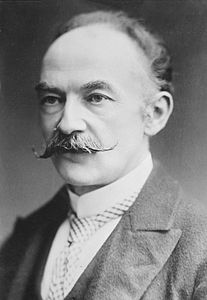Analysis of At a Hasty Wedding
Thomas Hardy 1840 (Stinsford) – 1928 (Dorchester, Dorset)
If hours be years the twain are blest,
For now they solace swift desire
By bonds of every bond the best,
If hours be years. The twain are blest
Do eastern stars slope never west,
Nor pallid ashes follow fire:
If hours be years the twain are blest,
For now they solace swift desire.
| Scheme | ABaAabAB |
|---|---|
| Poetic Form | Triolet |
| Metre | 110110111 111101010 111100101 110110111 11011101 110101010 110110111 111101010 |
| Closest metre | Iambic tetrameter |
| Characters | 289 |
| Words | 56 |
| Sentences | 3 |
| Stanzas | 1 |
| Stanza Lengths | 8 |
| Lines Amount | 8 |
| Letters per line (avg) | 28 |
| Words per line (avg) | 7 |
| Letters per stanza (avg) | 221 |
| Words per stanza (avg) | 54 |
Font size:
Submitted on May 13, 2011
Modified on March 05, 2023
- 16 sec read
- 100 Views
Citation
Use the citation below to add this poem analysis to your bibliography:
Style:MLAChicagoAPA
"At a Hasty Wedding" Poetry.com. STANDS4 LLC, 2024. Web. 29 Apr. 2024. <https://www.poetry.com/poem-analysis/36332/at-a-hasty-wedding>.


Discuss this Thomas Hardy poem analysis with the community:
Report Comment
We're doing our best to make sure our content is useful, accurate and safe.
If by any chance you spot an inappropriate comment while navigating through our website please use this form to let us know, and we'll take care of it shortly.
Attachment
You need to be logged in to favorite.
Log In